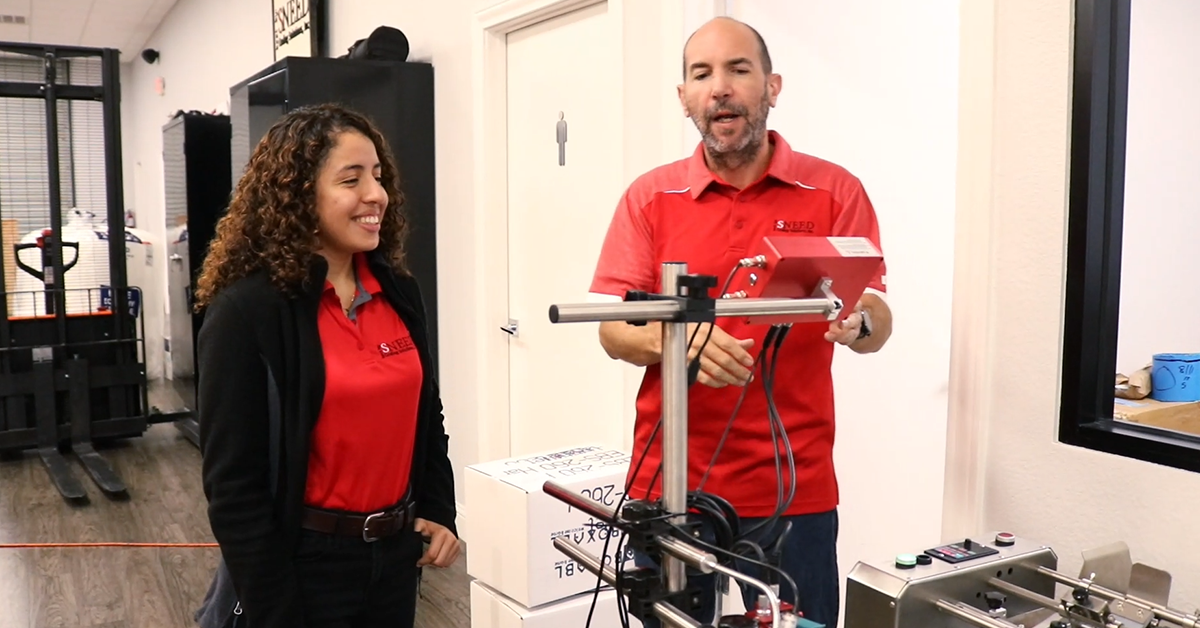Our VP of Technical Service is Giving Us a Behind the Scenes Look at the Coding Industry
Haven’t you ever wondered why out of all of the printing technologies available at Sneed Coding Solutions we decided to choose thermal-inkjet technology(TIJ)? There’s more to #KeepingCodingSimple than just stating it, but who better to give us an in-depth look at how thermal-inkjet technology compares to other printing technologies than our VP of Technical Services, Charles Collins; he’s been in the industry for over a decade, so if anyone can tell you about all of the different printing technologies it would be him. However, before Charles begins to school us on coding and marking options, let’s take a look at his start in the industry.
Starting Off and Progressing in the Coding Industry
Believe it or not, at one point in time, our VP of technical services was completely oblivious to the existence of the coding industry; hard to believe, right? However Charles goes on to say,
- “I had no idea coding and marking really existed, other than when I went to the store and looked for the expiration date on milk.”
Funny enough Charles’ start in the industry was completely by chance; a former acquaintance of his had been working in the coding and marking industry and had nothing but good things to say about it, so he decided to take the plunge.
- “I stumbled through the door and here I am 14, almost 15 years later; this career change has taken me all over the country and I’ve seen all different parts of the world, so it was definitely a step in a different direction, a much better direction.”
Initially Charles started as a technical service apprentice, where he spent days rebuilding and working on CIJ and VideoJet printers. After becoming a service technician the opportunity arose to go train at a thermal inkjet OEM facility. Charles has also had the opportunity to work on VideoJet, Domino, Markem Imaje, DOD, Micro-Jets, and Thermal-Inkjet technology.
Why Thermal Inkjet Technology?
Out of the endless amounts of printing technologies on the market, why thermal inkjet (TIJ)? According to Charles,
- “We prefer to keep things simple and TIJ is one of the simplest technologies available in the market, especially for entry-to-mid level customers.”
With TIJ printers, customers don’t have to worry about costly maintenance contracts, or rigorous equipment care, or even complicated application setups; our printers cover many of the applications that other technologies do but at a fraction of the time, cost, and hassle.
While other printing technologies require technicians to come out to your facility and install them, our printers are user friendly and typically consumers don’t struggle to install them into their existing workflows; however, if there’s any kind of issue whether it be installing or configuring the equipment, our technical service team is just one call away.
Why Don’t We Offer Other Printing Technologies?
Our motto is to “keep coding simple,” so we want to make sure that while we’re providing solutions to our customers, we’re offering them the easiest, simplest solution. While thermal inkjet technology does not cover every application, it has grown tremendously since Charles started; some of the advances made include:
- An increase in surfaces that the ink can adhere to
- An increased range in throw distance
- The elimination of the need for hazardous chemical disposal
- The elimination of the need for costly service contracts, technicians, etc.
We wouldn’t be able to stand by our “We Keep Coding Simple” motto if our coders were costing you an arm and a leg or causing you headaches, right?
What Are the Main Differences Between TIJ and CIJ?
While thermal-inkjet technology has grown tremendously over the past decade, it still hasn’t quite conquered every application just yet, especially because there are plenty of specialized inks that don’t quite fit into ink cartridges just yet. Speed is another aspect that continuous inkjet has thermal-inkjet beat in; for example, high speed canning lines that are going 1,000-1,200 feet per minute, are best paired with CIJ printers.
Sure CIJ still has us beat in the speed department, but we have them beat in the recovery department; while at some point in time our thermal-inkjet coders are bound to go down, it won't take hours, days, weeks or costly technicians to remedy the situation. With CIJ you're looking at prolonged down times, which means production has to come to a complete halt, while you wait for a technician to come out and fix your equipment. Think about it this way, with TIJ getting back on track is just a quick tech call away, while with CIJ you're wasting the day away.
What Are the Main Maintenance Differences Between TIJ and CIJ?
We’ve mentioned maintenance plenty of times throughout this blog, but what does that entail? When it comes to working with a CIJ printer you’re dealing with inks, moving parts, cleaning fluids, and so much more. For instance, it’s usually advised to stick with one color throughout the life of your continuous inkjet printer because if you choose to switch colors, then you have to schedule a tech to come out, flush out your system, replace your filters, refill your fluids, and then continue on. If you’re in a hurry to swap out your colors, then it might not be to your liking that the entire cleaning process can take anywhere from two to four hours.
We mentioned that CIJ has more moving parts, which means you’re going to have to replace parts more often; however, with TIJ printing technology, anytime you swap out an ink cartridge, you’re essentially replacing the printhead. In other words, there is no long-term wear and tear on any of our parts; another bonus is that swapping out colors doesn’t require a whole system flush, you can do it within 30-seconds or less. The most that you have to keep in mind when dealing with thermal-inkjet technology is remembering to cover your cartridge whenever it’s not in use and wiping it with a lint-free wipe when needed.
What’s the Cost Difference Between TIJ and CIJ?
Automating your coding and marking process does not always have to cost you an arm and a leg, but it really depends what coding system you decide to use. Like Charles said,
- “CIJ starts off considerably more expensive, on the low end you can find things under the $5,000 mark, but if you’re looking for pigmented inks, then you’re looking at the $9,000 or more range.”
- The average investment of a CIJ is more or less looking like $10,000 even on the bottom end because you have to have a technician come out and install; however it can get as pricey as $10,000-$15,000 if you’re looking for higher speeds, pigmented ink, etc.”
With our thermal-inkjet equipment, you’re starting off at the $600 mark, then when you begin to grow and add to your production line, you’re still looking at about $1,000. Both your upfront and ongoing costs are going to be significantly less, since our coders require less maintenance.
Interested in Learning Even More?
We could go on and on about thermal-inkjet technology and why it's our printing technology of choice, or you could hear it from the expert himself by checking out our SNEED-CAST interview: Why Thermal Ink Jet? Now's your chance to learn about the printing technology that could help you #KeepCodingSimple.




